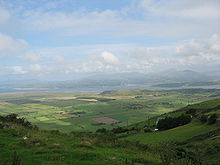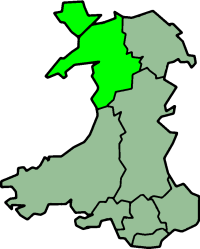Gwynedd
Gwynedd | |
|---|---|
 | |
| Admin HQ | Caernarfon |
| Largest city | Bangor |
| Government | |
| • Type | The Arms of the former Gwynedd County Council 1974–1996 http://www.gwynedd.gov.uk/ |
| • Control | Plaid Cymru |
| • MPs | |
| • AMs |
|
| • MEPs | |
| Area | |
• Total | 2,548 km2 (984 sq mi) |
| • Rank | Ranked 2nd |
| Population | |
| • Rank | Ranked |
| • Rank | Ranked |
| • Ethnicity | 99.0% White |
| Welsh language | |
| • Rank | Ranked 1st |
| • Any skills | 76.1% |
| Geocode | 00NC (ONS) W06000002 (GSS) |
| ISO 3166 code | GB-GWN |
Gwynedd (/ˈɡwɪn[invalid input: 'ɨ']ð/; Welsh pronunciation: [ˈɡʊɨnɛð]) is an area in north-west Wales, named after the old Kingdom of Gwynedd. As a local government area, it is the second biggest in terms of geographical area and also one of the most sparsely populated. Most of the population is Welsh-speaking. The name Gwynedd is also used for a preserved county, covering the two local government areas of Gwynedd and the Isle of Anglesey. Culturally and historically, the name can also be used for most of North Wales (for instance, the area covered by the Gwynedd Constabulary), corresponding to the approximate territory of the Kingdom of Gwynedd at its greatest extent. The current area is 2,548 square km (983.78 sq miles, slightly smaller than Luxembourg) with a population as measured in the 2011 Census of 121,874.[1]
Gwynedd is the home of Bangor University and includes the scenic Llŷn Peninsula, and most of Snowdonia National Park.
The largest settlements are Bangor, Caernarfon, Bethesda and Ffestiniog. The largest settlement in the south is Tywyn.
History


Gwynedd was an independent kingdom from the end of the Roman period until the 13th Century, when it was conquered by England. The modern Gwynedd was one of eight Welsh counties originally created on 1 April 1974 under the Local Government Act 1972, based on the principal territory of the former realm. It covered the entirety of the old counties of Anglesey, and Caernarfonshire, along with all of Merionethshire apart from Edeirnion Rural District (which went to Clwyd), and also a few parishes in Denbighshire: Llanrwst, Llansanffraid Glan Conwy, Eglwysbach, Llanddoged, Llanrwst and Tir Ifan.
The county was divided into five districts: Aberconwy, Arfon, Dwyfor, Meirionnydd and Anglesey.
The Local Government (Wales) Act 1994 abolished the 1974 county (and the five districts) on 1 April 1996, and its area was divided: the Isle of Anglesey became an independent unitary authority, and Aberconwy (which included the former Denbighshire parts) passed to the new Conwy County Borough. The remainder of the county was constituted as a principal area with the name Caernarfonshire and Merionethshire, reflecting that it covered most of the areas of those two counties. As one of its first actions, the Council renamed itself Gwynedd on 2 April 1996. The present Gwynedd local government area is governed by Gwynedd Council. As a unitary authority, the modern entity no longer has any districts, but Arfon, Dwyfor and Meirionnydd remain in use as area committees.
The pre-1996 boundaries were retained as a preserved county for a few purposes such as the Lieutenancy. In 2003, the boundary with Clwyd was adjusted to match the modern local government boundary, so that the preserved county now covers the two local government areas of Gwynedd and Anglesey, and the area of Conwy county borough is now entirely within Clwyd.
A Gwynedd Constabulary was formed in 1950 from the merger of the Anglesey, Caernarfonshire and Merionethshire forces. A further amalgamation took place in the 1960s when Gwynedd Constabulary was merged with the Flintshire and Denbighshire county forces, retaining the name Gwynedd. In one proposal for local government reform in Wales, Gwynedd had been proposed as a name for a local authority covering all of north Wales, but the scheme as enacted divided this area between Gwynedd and Clwyd. To prevent confusion, the Gwynedd Constabulary was therefore renamed the North Wales Police.
The Snowdonia National Park was formed in 1951. After the 1974 local authority reorganisation, the park fell entirely within the boundaries of Gwynedd, and was run as a department of Gwynedd County Council. After the 1996 local government reorganisation, part of the park fell under Conwy County Borough, and the park's administration separated from the Gwynedd council. Gwynedd Council still appoints nine of the eighteen members of the Snowdonia National Park Authority; Conwy County Borough Council appoints three; and the National Assembly for Wales appoints the remaining six.
Welsh language

Proportion of Welsh Speakers
Gwynedd has the highest proportion of people in Wales who can speak Welsh. According to the 2011 Census, 65.4% of Gwynedd residents aged three and over stated that they could speak Welsh.[2] The proportion of Welsh speakers in Gwynedd declined significantly from 1991 to 2001,[3] from 72.1% to 68.7%, respectively.[3] This occurred even as the proportion of Welsh speakers in Wales as a whole increased during that decade, to 20.5%. The Annual Population Survey conducted in 2016 estimates that 71.0% of people three years old and above in Gwynedd can speak Welsh.[4]
Fluency of Welsh Speakers
It is estimated that 83% of the county’s Welsh speakers are fluent – the highest percentage of all counties in Wales.[5]
Age and the Welsh in Gwynedd
The highest percentages of Welsh speakers in Gwynedd are within the 5-15 age group, with 92.3% of those people stating that they could speak Welsh.[5]
Towns, cities & major villages
- Bangor (pop. 18,808)
- Caernarfon (9,615)
- Blaenau Ffestiniog (4,875)
- Bethesda (4,735)
- Porthmadog (4,185)
- Pwllheli (4,076)
- Tywyn (3,264)
- Dolgellau (2,688)
- Nefyn (2,602)
- Barmouth (2,522)
- Penrhyndeudraeth (2,150)
- Llanberis (2,026)
- Bala (1,980)
- Criccieth (1,753)
- Harlech (1,447)
- Aberdyfi (1,282)
Notable people from Gwynedd
- Wayne Hennessey footballer, current Welsh national team goalkeeper, playing for Crystal Palace
- T. E. Lawrence, "Lawrence of Arabia"
- David Lloyd George, statesman and former Prime Minister of the United Kingdom, born in Manchester but lived in Llanystumdwy from infancy
- Owain Fôn Williams, footballer, currently playing for Inverness Caledonian Thistle
- Elin Fflur, Welsh singer
- Duffy, soul singer-songwriter
- Chico Slimani, of X Factor fame, resided for a short time in Llanystumdwy
- Opera singer Bryn Terfel
- Opera singer Gwyn Hughes Jones (Llanbedrgoch, 25-10-1969)
- Hedd Wyn, born Ellis Evans; the famous poet came from the village of Trawsfynydd
- Bryn Fôn, popular Welsh Singer and actor
- Group Captain Leslie Bonnet, RAF officer, writer and originator of the Welsh Harlequin Duck; and his wife Joan Hutt, artist
- Clough Williams-Ellis, architect of Portmeirion
- Sasha, DJ
- Charlie Owen, footballer
See also
- List of High Sheriffs of Gwynedd
- List of Lord Lieutenants of Gwynedd
- List of places in Gwynedd for all villages, towns and cities in Gwynedd
- List of schools in Gwynedd
- Llŷn Peninsula
- Snowdonia National Park
References
- ^ "Authority population 2011". Retrieved 18 May 2015.
- ^ "Welsh speakers by local authority and broader age groups, 2001 and 2011 census". StatsWales. Welsh Government. Retrieved 31 October 2016.
- ^ a b Census shows Welsh language rise. 14 February 2003. Retrieved 12 April 2007.
- ^ "Annual Population Survey estimates of persons aged 3 and over who say they can speak Welsh by local authority and measure". StatsWales. Welsh Government. Retrieved 31 October 2016.
- ^ a b "Anglesey & Gwynedd Joint Local Development Plan Topic Paper 10: Welsh Language & Culture" (PDF). Gwynedd County Council. Gwynedd County Council. February 2015. Retrieved 21 November 2011.

